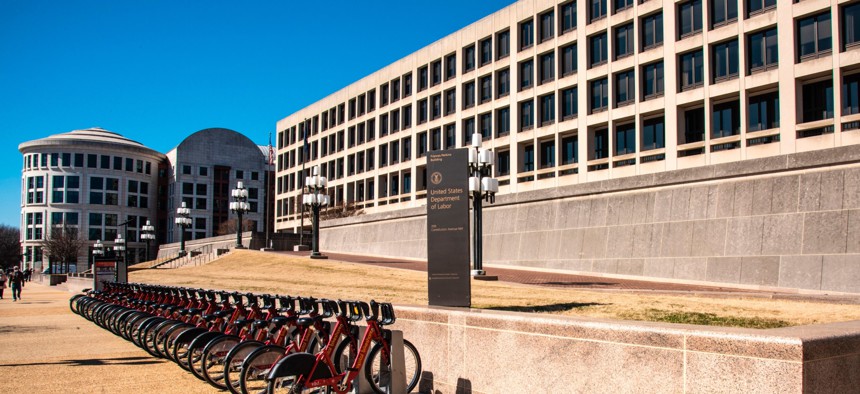Labor Department shifts unemployment modernization plans after Congress slashes funding

The Labor Department is revising its modernization goals after the debt ceiling agreement led to a $1 billion rescission of ARPA funding. Education Images / Getty Images
The department is also facing questions from Republican lawmakers about how it’s using unemployment-focused funding.
The Labor Department is adjusting to a new reality after lawmakers took back half of the $2 billion they’d previously given the department for modernization and fraud prevention in the unemployment system. That bonus funding was initially granted in 2021 but was then cut back as part of the debt ceiling compromise passed into law in June.
A department advisory issued July 13 lays out how the agency plans to spend the money it has left as part of a “comprehensive, strategic approach… to improve the future integrity of the UI system.”
On the same day, the department canceled previously announced funding opportunities for program integrity, equitable access and IT modernization.
Of the $2 billion Congress gave the department for unemployment insurance modernization in the 2021 American Rescue Plan Act, the agency has spent approximately $500 million, leaving only about $500 million left in unobligated funds after the $1 billion retraction.
That reduction in funding was part of the debt ceiling compromise negotiated between the White House and Congress, despite previous administration promises to veto a Republican-backed bill to claw back unobligated unemployment modernization funding.
Now, the Labor Department says that it is “deploying the remaining funds in concert with a government-wide focus on combating identity fraud in government programs, which intensified during the pandemic and continues.”
The department is putting up to $100 million of its remaining money towards grants focused on fraud prevention and overpayment recovery. About $200 million will be available to states for IT modernization, and states can tap into another approximate $77 million to implement findings from the department’s so-called tiger team work, where specialists team up with states to recommend improvements.
The department is also hoping to use remaining funds to give states access to federally operated identity proofing systems — the General Services Administration’s Login.gov and an in-person option at participating U.S. Postal Service locations — over the next two years, “subject to the availability of funding and necessary agreements being in place.”
States have until Aug. 18 to notify the Labor Department — which plans on covering transaction costs — if they're interested.
The Labor Department’s director of digital transformation, Akanksha Sharma, wrote in a recent blog that “at least half of U.S. states have expressed interest in adopting these technologies, and the Labor Department is looking to expand to all 53 state workforce agencies (50 states plus Washington D.C., Puerto Rico and the Virgin Islands).”
This work is meant to “further inform whether there is a need for standardized mechanisms for ID verification within the [unemployment] system as a potential long-term, federally supported sustainable public offering to states.”
The department has been testing the Login.gov and USPS-based ID proofing options already in an Arkansas-based pilot.
The latest guidance also offers states directions on what is required of them as they implement identity proofing and recover overpayments.
“At a minimum,” states should use data analytics and data matching to ferret out unemployment claims that warrant identity proofing, the guidance says. But states also need to be careful to not run afoul of equal opportunity and nondiscrimination laws as they look to tamp down on fraud.
“One of the most common barriers to equitable access is an ID verification process that is difficult to complete,” it says. “Another common barrier is states erroneously flagging legitimate claim activity as suspicious.”
The department’s new plan comes as both states and the federal department continue to grapple with fallout from the pandemic. States struggled to adapt to a huge expansion in benefits at the start of the pandemic, rapid increases in claims and fraud attacks.
Although the exact toll is unclear, the Government Accountability Office estimated in February that at least $60 billion in unemployment went to fraudsters over an 18-month period starting in 2020. The same month, the Labor Department’s own inspector general gave an estimate of $191 billion in improper payments, “with a significant portion attributable to fraud.”
In the new guidance, the department notes that state systems went into the pandemic “after experiencing the lowest claims workload in 50 years, and thus the lowest administrative funding, which significantly impacted resources and staffing levels available to the states to manage the huge influx of claims.”
Moving forward, the Labor Department will also have to contend with questions from Capitol Hill on how it's making progress.
Some of the same lawmakers who originally proposed clawing back some of the Labor Department's money for unemployment insurance modernization sent the department a letter on Thursday asking for more information on how the department has used the money it's already spent.
House Ways and Means Chair Jason Smith, R-Mo., and Senate Finance Committee Ranking Member Mike Crapo, R-Idaho, accused the department of having a “lack of transparency in how the funds have been spent,” continuing to write that the law that gave the department the funding was too broad. That law laid out three goals for the funding — improving access and equity to unemployment and preventing fraud.




